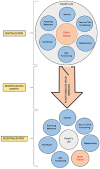Parents' Vicarious Event Centrality of Their Child's Interpersonal Trauma
- PMID: 38642037
- PMCID: PMC11538790
- DOI: 10.1177/08862605241247571
Parents' Vicarious Event Centrality of Their Child's Interpersonal Trauma
Abstract
This study aimed to understand parents' process of centering their child's interpersonal traumatic event in their lives post-disclosure. Specifically, how it informed their understanding of themselves, their lives, and the world. This phenomenon of centering a traumatic event in one's life is termed event centrality and has not been previously applied to qualitative research or this population. Participants were 17 primary caregivers (14 maternal caregivers and 3 paternal caregivers) of 27 victims of child interpersonal trauma (14 males and 13 females) located in Canada. The age of participants ranged from 35 to 75 years (average = 54.5 years) and majority self-identified as Caucasian (70.6%). Grounded theory was used to analyze the data. The resulting model was labeled Vicarious Event Centralization and Decentralization, indicating that parents center their child's interpersonal trauma across many areas of their lives, which orients them to focus on protecting and healing the child. After the child's functioning improves, parents are then able to reorient to life beyond the trauma, representing decentralization. The grounded theory consists of three phases: Centralization, Decentralization Gateway, and Decentralization. These results illustrate that parents' centralization of the trauma may be an adaptive mechanism that promotes child recovery, which in turn allows parents to begin to decentralize the trauma and move toward recovery. This study supports that parents are affected by their child's trauma in a myriad of ways and require unique services to address their needs. This study can help practitioners understand the post-trauma experience for parents and target areas likely to increase recovery.
Keywords: caregivers; child interpersonal trauma; grounded theory; indirect trauma; parents; vicarious event centrality; vicarious trauma.
Conflict of interest statement
Declaration of Conflicting InterestsThe author(s) declared no potential conflicts of interests with respect to the authorship and/or publication of this article.
Figures
Similar articles
-
Transformational change in parenting practices after child interpersonal trauma: A grounded theory examination of parental response.Child Abuse Negl. 2018 Feb;76:117-128. doi: 10.1016/j.chiabu.2017.10.005. Epub 2017 Nov 2. Child Abuse Negl. 2018. PMID: 29101832
-
Parents' Experiences of Their Child's Disclosure of Child Sexual Abuse.Fam Process. 2020 Dec;59(4):1773-1788. doi: 10.1111/famp.12507. Epub 2019 Nov 12. Fam Process. 2020. PMID: 31715020 Review.
-
Zoning in on parents' needs: understanding parents' perspectives in order to provide person-centered care.Epilepsy Behav. 2014 Aug;37:191-7. doi: 10.1016/j.yebeh.2014.06.029. Epub 2014 Jul 20. Epilepsy Behav. 2014. PMID: 25050778 Free PMC article.
-
Comparison of parent and child reports of emotional trauma symptoms in pediatric outpatient settings.Pediatrics. 2005 May;115(5):e582-9. doi: 10.1542/peds.2004-2201. Pediatrics. 2005. PMID: 15867023
-
Parents' experiences with physical and occupational therapy for their young child with cerebral palsy: a mixed studies review.Child Care Health Dev. 2014 Nov;40(6):787-96. doi: 10.1111/cch.12097. Epub 2013 Aug 13. Child Care Health Dev. 2014. PMID: 23937711 Review.
References
-
- Birks M., Mills J. (2015). Grounded theory: A practical guide. Sage.
-
- Boals A., Murrell A. R. (2016). I am > trauma: Experimentally reducing event centrality and PTSD symptoms in a clinical trial. Journal of Loss and Trauma, 21, 471–483.
-
- Boals A., Schuettler D. (2011). A double-edged sword: Event centrality, PTSD and posttraumatic growth. Applied Cognitive Psychology, 25, 817–822.
MeSH terms
LinkOut - more resources
Full Text Sources


